I parked my camper between two thorn trees on the Drove, just passed the crossing where the old A344 used to run, and spent the night there.
In the morning there was a frost, despite the lateness of the season, with a thin mist rising in the hollows as the sun began to warm the landscape.
It was May the 1st: Beltane.
The Drove—full title “the Netheravon Cattle Drove”, also known as Byway 12—is an ancient right of way cutting across Salisbury Plain. Historically it was probably used to drive cattle from the village of Netheravon to Salisbury Cattle Market: hence its name.
It is a wholly unremarkable stretch of unmade road, pot holed and rutted, with a few scattered thorns along the verge. What gives this road its special significance is where it passes on one part of its journey: along the stretch from Lark Hill to the A303 it skirts Stonehenge on its Western side, close enough to get a good view of the monument without having to pay English Heritage for the privilege.
The current cost of entry to Stonehenge is £15.50 for adults, £9.30 for children, or £13.90 for students and senior citizens.
Tickets have to be booked in advance.
Park up on the Drove and you can get almost as close for free, without booking, and without the annoyance of having to pass through English Heritage’s new £27 million Disneyfied visitor centre.
Not that I was there to see the monument today, enigmatic and mysterious though it is. I had other purposes in mind.
By now my co-conspirators were arriving. I could see Kazz and Arthur on their Motorbike weaving slowly back and forth across the track to avoid the ruts, while I made my way to join them. There were about a dozen of them there by now, many already wearing their white robes with the red rampant dragon symbol on the front: the Loyal Arthurian Warband, or some of them at least.
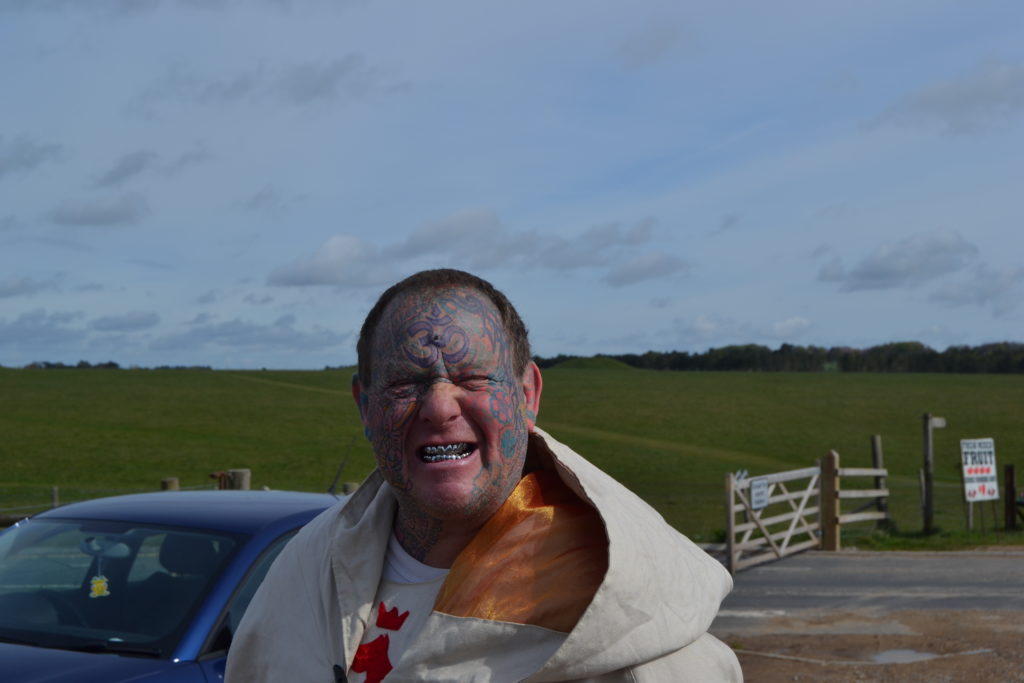
I’ve known Kazz and Arthur for a long time: Arthur since the mid-nineties, when I first mooted the idea of writing a book about him. Just to clarify, in case you haven’t heard of him: he’s this ex-biker, ex-soldier turned Druid who in 1986 had a revelation that he was the reincarnation of the historical King Arthur, and who has been living his life as such ever since. And if you think that’s eccentric, you haven’t met the others yet.
“CJ, do you know Mad Alan?” Kazz said, introducing me to one. He had a shaved head and was wearing a short hooded robe. His legs were bare, showing a number of tattoos. His face was almost completely tattooed, in pink and blue psychedelic swirls that reached into his ears. I was studying these, wondering how painful it must have been to have the needle drill in such an intimate place, when I spotted something even more remarkable glinting from his forehead.
“Is that a nail?” I asked.
It was. A tiny silver nail, lodged a few inches above his nose, in the place where the third eye is reputed to be.
How often do you meet someone with a nail banged into his forehead?
After which which he spoke about his titanium teeth, and gave a clenched-teeth grimace to show them off. A full set: shiny and silver in his gob, like Jaws from the Bond movies.
No need to ask why he’s called “Mad Alan” then.

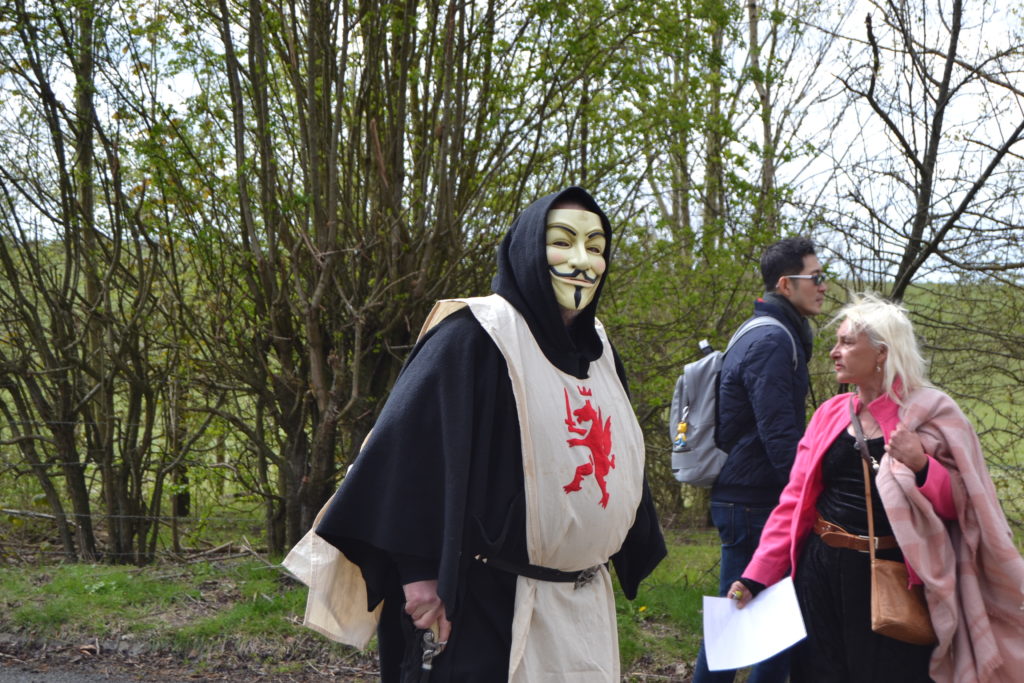
The Drove was our rendezvous. Our destination was across the National Trust field where a number of burial mounds are situated, to Fargo Plantation, a small stretch of wood about half a mile distant.
Veterans of the Stonehenge Free Festival will remember that field. It was where the festival took place. And Fargo Plantation was where they collected wood for their fires.
In the wood we held a circle for Beltane, holding hands and repeating the Druid’s vow three times as is customary:
“We swear by peace and love to stand, heart to heart and hand in hand; mark oh Spirit and hear us now, confirming this, our sacred vow.”
And so to business.
The wood is riven by a stretch of tarmacked road. This is the old A344, which used to run from the A303 to the A360 at Airman’s Corner. These days it belongs to English Heritage, who use it to bus the tourists the 2km or so from the visitor’s centre to the Stones and back.
Either side of the road it is National Trust land, and at this point in the road, near the old Airman’s Cross, there is a public right of way.
Let’s say those words again, just so we register their significance.
“Public.”
“Right.”
“Of way.”
So, now, we are the public, and this is our right of way, which, despite English Heritage having taken possession of the road, we are still entitled to use.
Which is what we proceeded to do: to walk across the road and back again—back and forth, back and forth—from one National Trust field to the other, holding signs which said, “We Will Not Pay To Pray” and other such arcane and mysterious slogans.
Why did the Druids cross the road? To stop the English Heritage tourist buses from getting to the other side.
At this point maybe we should take a pause to consider what this is all about. It’s a protest. We are here to protest English Heritage’s plans for the Summer Solstice Managed Open Access this year, which include a £15 car-parking charge for most vehicles and an alcohol ban in the Stonehenge field.
Managed Open Access has been happening since the year 2000, four times a year, on the two solstices and the two equinoxes—all night for the Summer Solstice, and three hours each at dawn for the other three—and up to now it’s been free.
The Summer Solstice in particular is an event of world renown: with people including it on their bucket list of things they want to do before they die. As many as 37,000 people turned up in 2014, a record which looks set to increase as the years go by.
Prior to that, of course, from 1985 to 1999, there was a four-mile exclusion zone around the Stones, which, if you stepped over, you would get yourself arrested.
The cost of policing this operation, which involved hundreds, sometimes thousands, of police from a number of different constabularies —all on overtime as it took place overnight – plus helicopters, dog units, command and control centres, catering facilities, riot vans, secure vehicles and all the rest—not to speak of the cost of incarcerating dozens of people in police cells around the county—amounted to hundreds of thousands, possibly millions, of pounds every year.
Arthur was one of the people arrested on a regular basis during those fourteen long years, and actually took the British Government to the European Court of Human Rights over the issue.
Managed Open Access has been considerably cheaper: some mobile toilets, moderate policing, security guards, catering facilities, infrastructure, not much more.
But English Heritage, a former quango, is a charity these days, and everyone has to tighten their belts in this age of austerity. Stonehenge is far and away EH’s most lucrative asset, but the cost of the new visitor’s centre – described by Will Self in the Guardian as “an orgiastic union between Mammon and science” – and the requirement to cash in on the tourist dollar in order to justify its existence, means that some of the rival claims to Stonehenge’s mystic aura have had to be squeezed out.
That means specifically all the people that Arthur considers his congregation and who he refers to as “pilgrims”: the new-age mystics and pagan travellers who arose during the years of the festival and who think of Stonehenge as “their” temple.
You might say they have as much right to it as anyone else, the builders not being around any more to stipulate what it should and shouldn’t be used for.
Arthur believes that the £15 car-parking charge is discriminatory. The tourists pay £5 for the same privilege, which is then refunded when they pay for the ticket, while the alcohol ban means that Druids won’t be able to partake of their ritual Mead. He also points to the hypocrisy of English Heritage who, he says, had a grand opening night in the Stones a while back in which all the assembled dignitaries were quaffing champagne. So it’s “one rule for the rich” as always.
There is also a planned £50 charge for vehicles larger than a camper van: this means converted buses and trucks, which are the mobile homes the New Age Travellers prefer, making it patently clear that it is this group in particular that English Heritage want to banish from the Stones.
And so back to our protest.
By now the tourist buses were stuck on either side of the procession, unable to move. The occupants were made to get out and walk. Meanwhile the Warband were tramping back and forth across the road shouting various slogans.
“Money grubbing English Heritage. We will not pay to pray. Stonehenge, our temple. English Heritage rip off the tourists. Etc. etc.”
Arthur’s idea was that by stopping the buses we would cause a backlog on EH’s timed ticket slots, which now have to be booked in advance, thus costing them money. “Money is the only thing they understand,” he said, “so we plan to cost them as much of it as we can.”
Mad Alan and Bubba—half punk, half Druid, wearing a Guy Fawkes mask and a hood—were arm in arm singing Beatles songs: “All you need is Love, love love love, love is all you need.”
“Love” is Mad Alan’s favourite word.
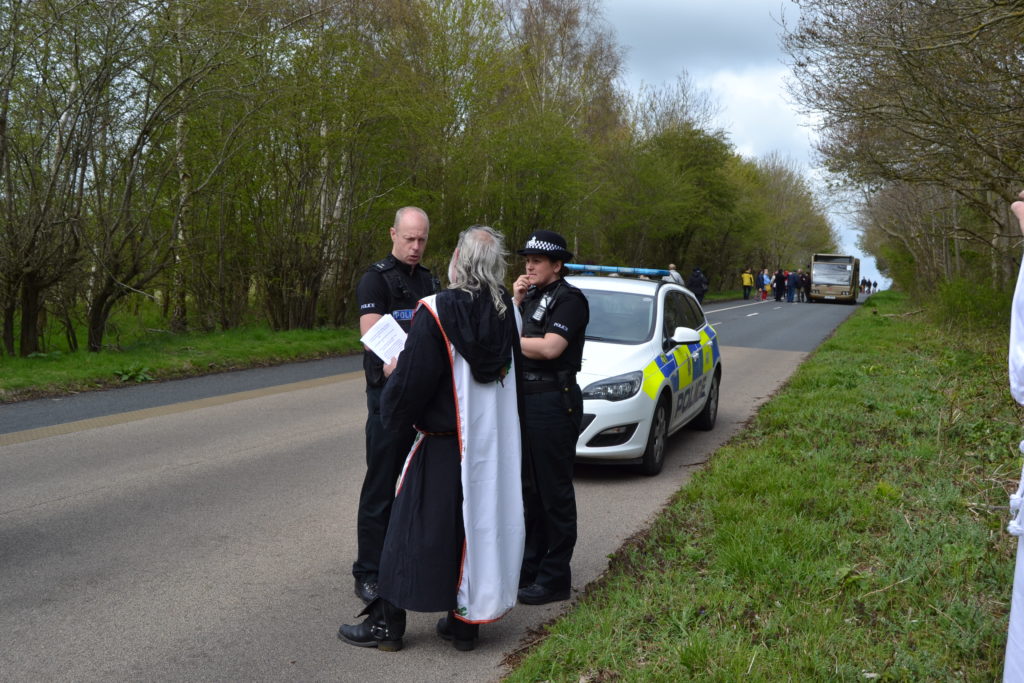
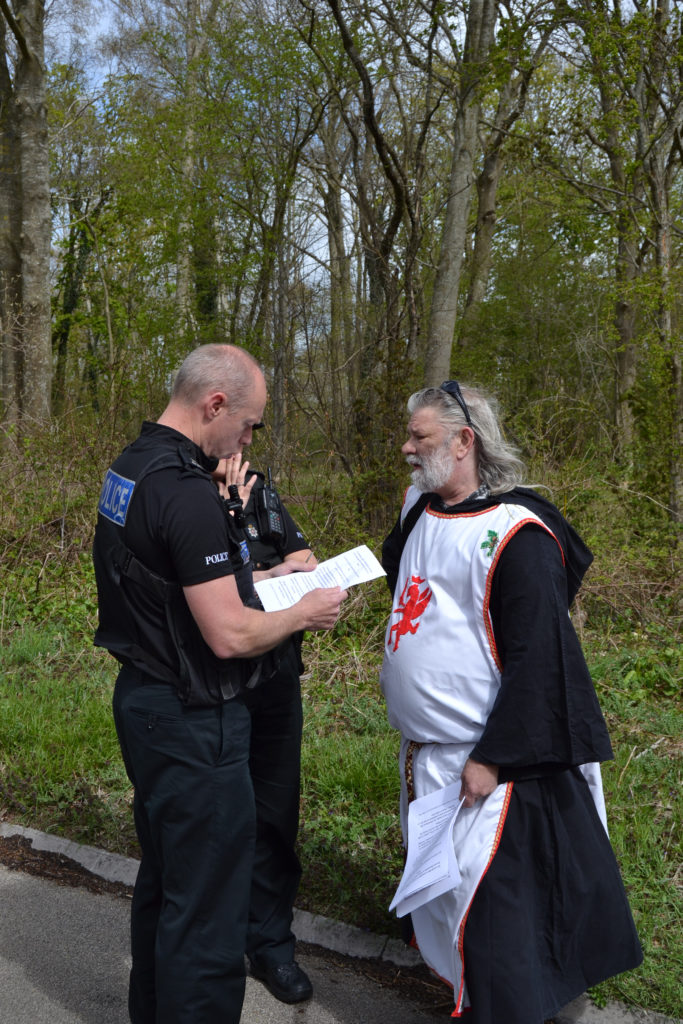
At a certain point the police turned up, one male, one female, in a squad car.
They threatened Arthur with the Criminal Justice Act 1996, Trespassory Assembly.
“I was the first person to get arrested under that law,” said Arthur. “And the first Not Guilty.”
After a while they visibly softened. The male officer took his hat off and tucked it under his arm, which is always a good sign.
“What do you want?” he sighed, with a note of world-weary resignation in his voice.
Arthur asked to speak to a senior person from English Heritage and gave his demand, which was that they should withdraw the enforced car-parking charges and the alcohol ban immediately and return to the table to negotiate.
The stand off lasted a number of hours. Kate Davies, English Heritage’s manager at Stonehenge, was unavailable, and a lesser official came down. She said she was unable to make any decisions about the solstice at this point. The rumour was that EH were giving away free cream teas to compensate the tourists for their inconvenience.
Meanwhile, as they were now being made to walk to the monument instead of being taken by bus, Arthur changed his slogan.
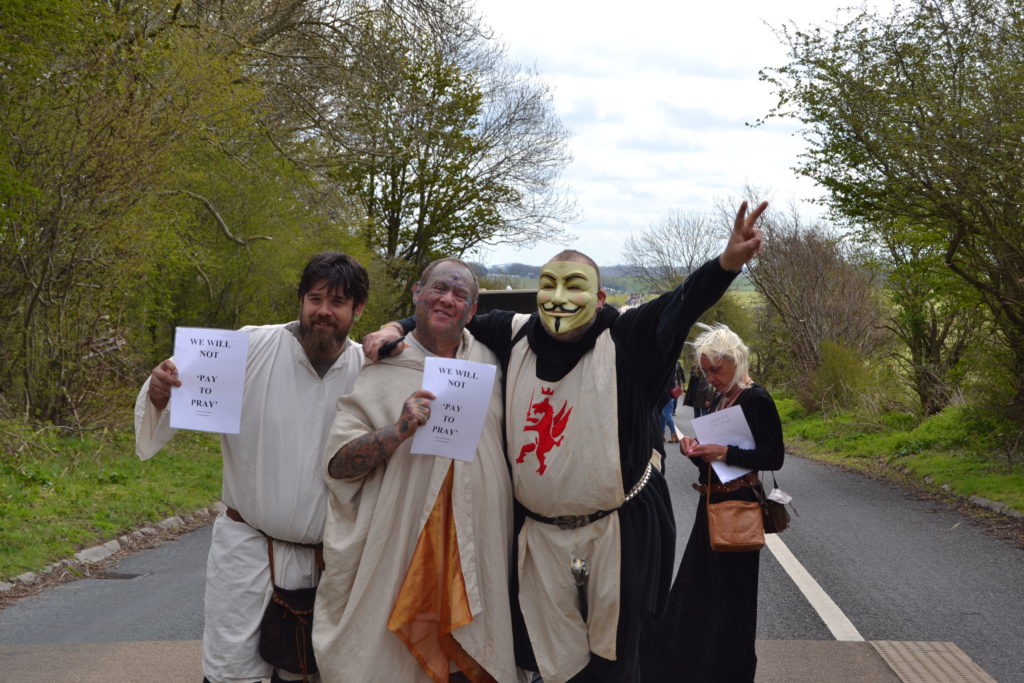
“We will not be made to pay to pray,” he shouted, “and you should not have to pay to walk. Ask for your money back.”
There were negotiations with the bus drivers who were allowed to take a few old people and people with disabilities back to the visitor’s centre. Some of the tourists loved the sight of the Druids in their robes. They thought it was all part of the entertainment. Others got very angry and accused them of being weirdos. Mad Alan took that as a compliment.
Eventually the protest wound down. Arthur told the EH official that most of the people there lived in Salisbury and could do this again, any time they liked. He called it his “pop up protest”.
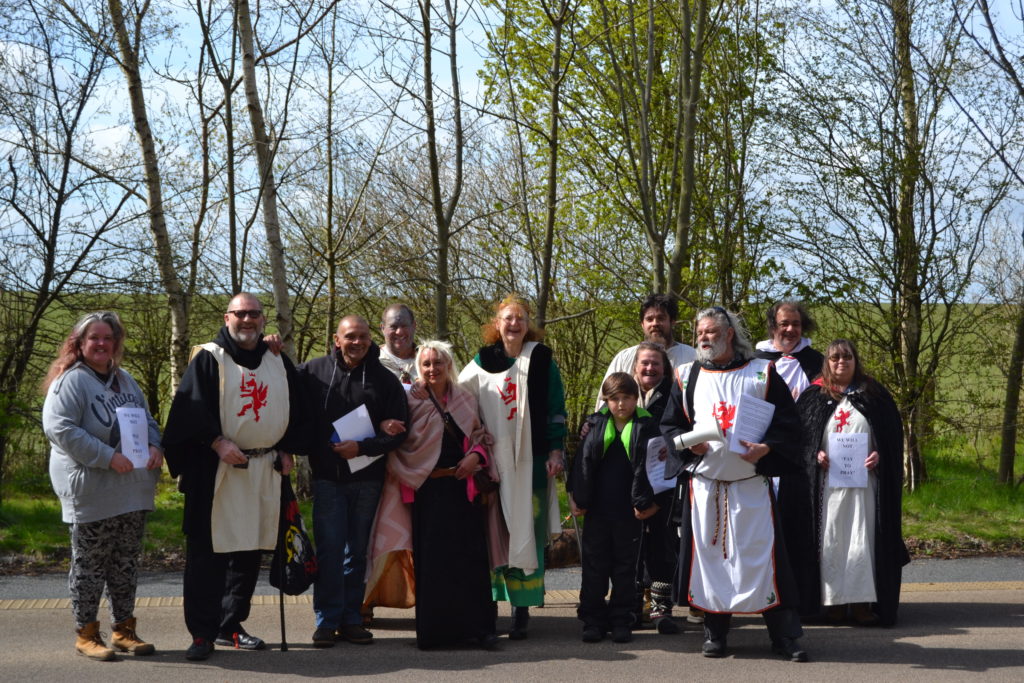
As for the future, the Solstice is fast approaching, and EH still intends to implement the car-parking charges, which Arthur says are illegal under European law as they discriminate disproportionally against the pagan community.
“I’ll be there on the night,” he says, “advising people not to pay. What can they do? If they try to tow any vehicles away, we’ll see ’em in court.”
Christopher Stone
Warband website: http://www.warband.org.uk/
Christopher Stone’s blog: https://christopherjamesstone.wordpress.com/
The Trials of Arthur: https://www.amazon.co.uk/Trials-Arthur-Revised-Pendragon/dp/0956416314
“Stone writes with intelligence, wit and sensitivity.” Times Literary Supplement
“Passionately serious, irresistibly compelling, and hilariously good-humoured.” Professor Ronald Hutton, Bristol University
“Searching, funny, intelligent and illuminating.” Deborah Orr, the Guardian.
Publications: The Guardian Weekend * The Observer * The Big Issue * The Independent * The Independent on Sunday * The New Statesman * The London Review of Books * Mixmag * The Sunday Herald * The Times Literary Supplement * Prediction * Kindred Spirit * The Whitstable Times * Saga Magazine * Kent Life * The Whitstable Gazette *
Books: The Empire of Things (Gonzo Muiltimedia 2013) * The Trials of Arthur Revised Edition (with Arthur Pendragon: Big Hand Books 2010) * Dear Granny Smith (as Roy Mayall: Short Books 2009) * The Trials of Arthur: The Life & Times of a Modern Day King (With Arthur Pendragon: Thorsons/Element 2003) * Housing Benefit Hill (AK Press 2001) * The Last of the Hippies (Faber & Faber 1999) * Fierce Dancing: Adventures in the Underground (Faber & Faber 1996) *

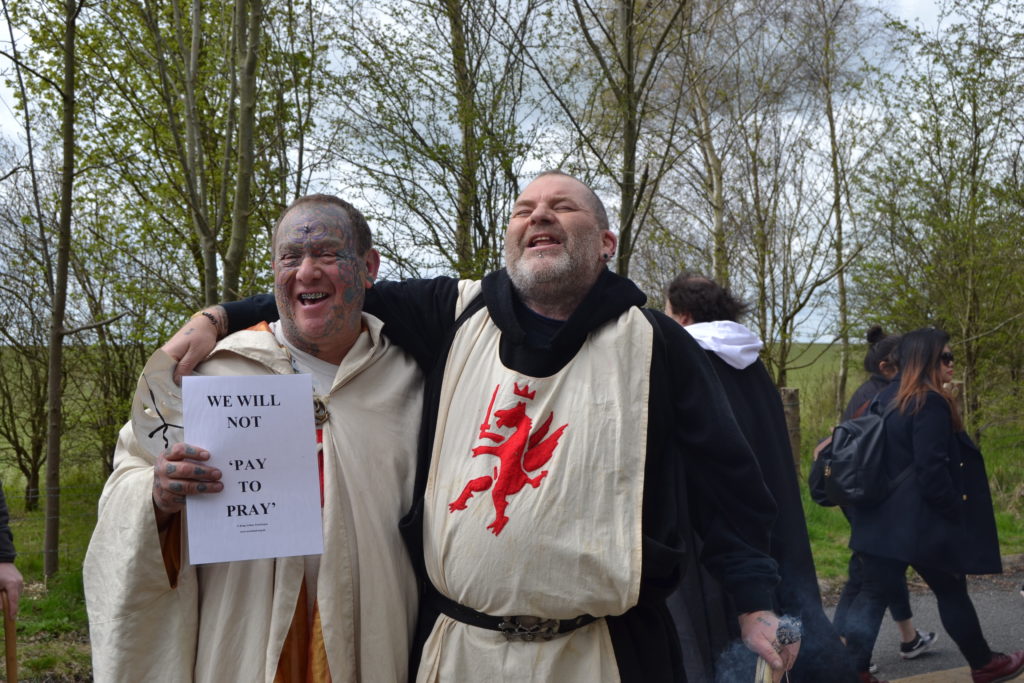
Good article with one error – the Wiltshire council website has a map showing all the public rights of way and there isn’t one at that spot near Fargo Woods.
Comment by Jon on 26 May, 2016 at 8:46 amHail Jon,
Comment by King Arthur Pendragon on 26 May, 2016 at 12:13 pmThere is a Right of way and a Field Gate either side to access from one NT field to the other. Was put in when EH took over the A344. Blessings Arthur /|\
Jon, the Wiltshire council website doesn’t show every right of way because that is one, whether the website shows it or not. There’s a National Trust field on one side of the road, and a National Trust field on the other, and a right of way across the road joining them.
Comment by Christopher J Stone on 26 May, 2016 at 2:25 pm[…] Continue reading: http://internationaltimes.it/stonehenge-byway/ […]
Pingback by Stonehenge Byway | Fierce Writing on 26 May, 2016 at 2:36 pmAwesome report and I wholeheartedly support Arthur and the Warband in this matter. We shouldn’t have to pay to pray ? Wishing you all good luck to all those on the from line. Bright Blessings )0( /|\
Comment by Heather Elston on 26 May, 2016 at 4:56 pmWonderful stuff. I’d have joined in!
Comment by Pam Radford on 26 May, 2016 at 6:37 pmWell done King Arthur Pendragon and C J. We the People.
Comment by Ru Callender on 26 May, 2016 at 8:18 pmExcellent article, Chris! It describes the situation at Stonehenge very well and what Arthur, Kazz and the LAW are doing about it!
Comment by Steve Andrews on 18 June, 2016 at 8:57 amGreat article by Christopher Stone, and a formidable, justified, protest!
Comment by Jane Johnson on 18 June, 2016 at 6:25 pmLandmarks, Temples, Prehistoric monuments such as Stonehenge are world heritage sites, Existing in our time from unknown origins. Stone circles, planetary events, are the sigils of a consciousness pre-existing the ‘Modern European Mind’, our consensus reality, and are not rentable, translatable, into the medium of money. No more is sunshine, rainfall, wind or seasonal temperature change. A monument or solar temple, a marker that is oriented to the Earth’s orbit around the Sun (can we at least agree on that?) is not a business proposition, any more than the shadow cast by a great oak tree is a foundation for rented shade.
The society that is itself bound by oisive collection of shiny shekels, substitute shining disks, magpie-like acquisitive plutocratic endeavours, is supporting the caddis fly sheath, not the live larva, and will never see even a mayfly existence to live in the brilliance of the light. The discriminative value system engendered by monetary dependence, that attributes status to those with wealth, is itself life turned to stone, denial of the living bright creative fire that is the source of life on earth,
If Stonehenge is a monument to anything, it is that this cradle of structures, manifestation of the material, is only brought to life when the light and warmth, the dawn ray of the Solar Logos, enters in to awaken, quicken it, as in Spring’s heraldic visit, proclaiming the royal sun’s return, and the August glory that gives all creatures fruition by the means of that fiery gift. Without the Sun there is no light, no life, no embodied consciousness, no breath. We are spirits in the unbecoming and unbirthing wastes of space, wistful and unfulfilled. Life on earth is made possible by his solar majesty, the nearest visible manifestation of divinity in our world and lifetime. So to worship and give thanks for that, is a natural right, duty, privilege, that shall not be taken from us, by greedy bureaucrats and blind bankers.
Thanks to Arthur, Kazz, and all those who manifest their protest, to make the statement of liberty and freedom, to give love and gratitude for this life on the special longest day and at the stations of the year, in a place created by our ancestors, probably for the same purpose.
rights of way have been lost all round Salisbury, I walked some as a school boy, the foot bridges have been removed or allowed to fall apart, and fences have been erected. I had a map , back in the 1950’s, showing all that remained then and most have vanished, who needs English Heritage anyway ? solstice and the stones were free access for everyone, ask any of my generation
Comment by Michael A. Hipwell on 16 November, 2021 at 5:58 pmLandscapes speak, and if you don’t hear it, look at the burial mounds of ancestors, listen to the choirs of Skylarks, feel the sun and the wind and connect with nature as you pass along Byway 12. Somehow it seems far more appropriate to make the journey to Stonehenge along Byway 12. It’s far more sustainable and much more enjoyable than being stuck in the long traffic jams on the A360 and A303.
Comment by Alan Kinnaird on 8 July, 2023 at 1:59 pmOur journey to the Solstice starts miles away, when we put our mountain bikes on the train to Salisbury and then cycle up Downs to Byway 12. We were late this year (2023) and as dusk fell we could see lightening in the distance. It had become pitch black by the time we reached the Byway, which was easily spotted with its welcoming ‘Road Closed’ sign. Every time we come its closed! In the distance, the Army provided a better welcome with a barrage of high parachute flares, which which floated silently amongst the stars. As we headed for Stonehenge along the Byway, at intervals we could see the red lights of the vehicles that were stuck in the traffic jams, and when we couldn’t see them, in the darkness of the night, we were amazed to hear the sound of drums floating on the wind and the night had become alive. Somewhere in the dark we passed some friendly people coming back from meeting friends. Sadly no grunting was heard from the ‘Great Pig Farm’ because it has disappeared, and its presence replaced by flowing fields of wheat and barley. Then a flashing drone was seen dancing in the sky before we saw the lights at Stonehenge. We then reached more ‘Road Closed signs at the A303 and boldly crossed it between the queuing traffic. ‘How long is the queue? called the waiting drivers as we guided some teenage cyclists to the stones. And then we arrived. It seems bonkers that the facility to lock up cycles is fenced off and we all had to lock our bikes to a farm gate on the Byway. Fortunately there aren’t that many of us, but it could be improved. As always it’s magical to step off the Byway and on to the hallowed ground of Stonehenge to enjoy a ‘Happy Solstice.’ The sense of the Henge’s positive atmosphere is immediate. For those who gaze at the sky on nights such as this, and look for inspiration, three meteors caused three flashes of light to strike the heavens above Stonehenge in the night just before dawn and and natures mists. If you weren’t looking you would have missed this. Many thanks to Arthur for keeping it open, to Rolo for his Service and prayers of Peace, to Raven for blowing the horn, to Simon for his knowledge of the heavens, to the choirs of crimson ladies that sang, to the ladies with floral hair, to the men who revere the Oak, to the drummers of the night, to those who were absent, and to the Sun, who made a rather special and spectacular appearance above the mists of time to rise above the Heelstone and shine on the world once again. I raise a glass. It should be mead, but this year its blackberry cider and its very good.